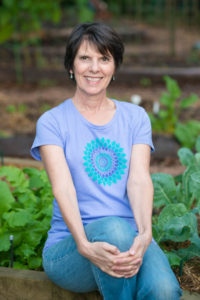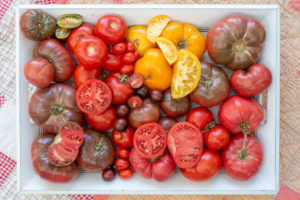
The wait for juicy tomatoes is finally over!
May brought the rain and pleasant gardening weather and June brings the heat and abundant sunshine to the vegetable garden. And with onion tops falling over, bean pods growing longer, cucumbers filling out, potato plants dying down and tomatoes coloring up it is also a big harvest month for many gardeners.
Storage Crop Harvesting Tips
Here are some tips for harvesting storage crops that usually reach maturity this month:
Garlic
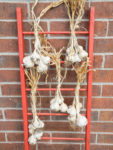
Dried garlic plants can be hung in a cool, dark location, cutting off a bulb as needed.
Garlic leaves that begin to yellow are an indication that bulbs are ready for harvest. Dig the plants with a spading fork or shovel being careful to keep the bulbs and leaves intact. Lay or hang in a dry, shady area for 2-3 weeks, until leaves have dried completely. After this curing process brush the dirt away and trim the roots and cut the leaves off an inch above the bulbs. Store bulbs in a location that is cool and dry with good air circulation. Alternatively, leaves can be braided and hung for storage.
Onions
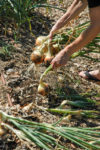
Harvest onions when their necks soften and the tops fall over.
Onions signal that they are ready to harvest when their necks soften causing the tops to fall over. Gently pull the bulbs and lay them side by side in dappled sunlight to air-dry for several hours then spread them out in a well-ventilated, sheltered area for about a week. Once the leaves have dried completely cut them off an inch above the bulbs, trim the roots and store the onions in a cool, dry location away from direct sunlight. Short day varieties are not long keepers and should be used within 2-3 months. Check regularly for decay.
Potatoes
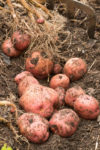
Dig potatoes carefully; any potatoes nicked or bruised during harvest may be prone to spoiling and should be eaten soon after harvest rather than stored.
Potatoes are ready for harvest when the tops turn yellow and die down. Be sure to dig potatoes after a stretch of dry weather as you don’t want to harvest tubers that are moist or wet to avoid the risk of disease. Use a spading fork to carefully loosen the soil as you dig in from the side of the plant, breaking the soil apart with your hands as you check for potatoes. Spread the potatoes in a single layer in a dark, dry location to allow the skin to cure then store in a shallow bin or box in a cool, dark location. Gently brush the dirt away before storing but do not wash until you are ready to eat them. And there is no reason to peel your home-grown potatoes before you prepare them – much of the nutrition is just under the skin.
June Vegetable Garden Checklist:
Water
- Be prepared to water and provide shade as needed to help plants thrive during the coming hot and dry summer months.
Soil
- If gardening through the heat of summer isn’t your thing that’s ok. Give yourself and your beds a rest with a layer of mulch or compost.
- Add a top dressing of compost or mulch to retain moisture.
Fertilize
- Plants that are ready for harvest usually don’t need additional fertilizer since they are nearing the end of their lifecycle. Add fertilizer to actively growing plants only if needed by scratching the fertilizer into the top layer of soil and watering deeply to quickly move the nutrients into solution. Alternatively, use a liquid fertilizer and a siphon mixer to deliver through your irrigation system.
- Provide supplemental iron through foliar applications or drench, if needed, before daytime temperatures exceed 80°F. Dr. Larry Stein from Texas A&M University recommends EDDHA water soluble chelated iron because it performs the best in alkaline soils.
Plant/Transplant
- Start seeds for fall tomatoes this month so you will have transplants ready to set out in late July or early August.
- If you want to keep your garden growing though the summer with heat-loving vegetables try okra, melons, sweet potatoes, Malabar spinach or Southern peas.
- Plant buckwheat as a cover crop in empty garden beds. Buckwheat grows quickly and its blossoms attract pollinators.
Diseases/Pests to Look For
- Spider mites like it hot and dry; watch for infestations on beans, squash, tomatoes and cucumbers. The leaves will have a stippled appearance. Organic controls for spider mites include horticultural oils or sulfur dust. Washing the underside of the leaves with a strong spray of water every few days can also help prevent mites from becoming established.
Maintenance
- Visit the garden frequently to monitor for pests and disease
Harvest
- Pick vegetables before they get overgrown. Harvest regularly to encourage continual production. Some crops, like okra, may need to be harvested more than once a day.
-
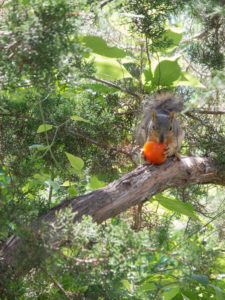
Harvest tomatoes before they are fully colored to avoid damage from birds, bugs, and tomato-thieving squirrels.
Tomatoes are at their absolute best when they have reached full color on the vine. Gently twist or cut the stem from the plant. If bugs, birds or squirrels are an issue fruit can be harvested early (at the turning stage, just after color begins to develop at the blossom end) and allowed to ripen indoors. Though not quite as satisfying as a vine-ripened tomato it is preferable to the alternative of tomatoes pecked, half-eaten or stippled with bug damage. For best flavor and texture, store tomatoes at room temperature.
- Harvest cucumbers when they are the appropriate length; pickling cucumbers are ready at 3-4 inches, slicers are ready at 6-8 inches and oriental cucumbers may grow to 12-14 inches.
Additional Resources
Join us for the Vegetable Gardening in Central Texas Webinar
Recommended Vegetable Varieties for Travis County
Sustainable Food Center Farmers Markets
Monthly Gardening Calendar for Austin and Central Texas
